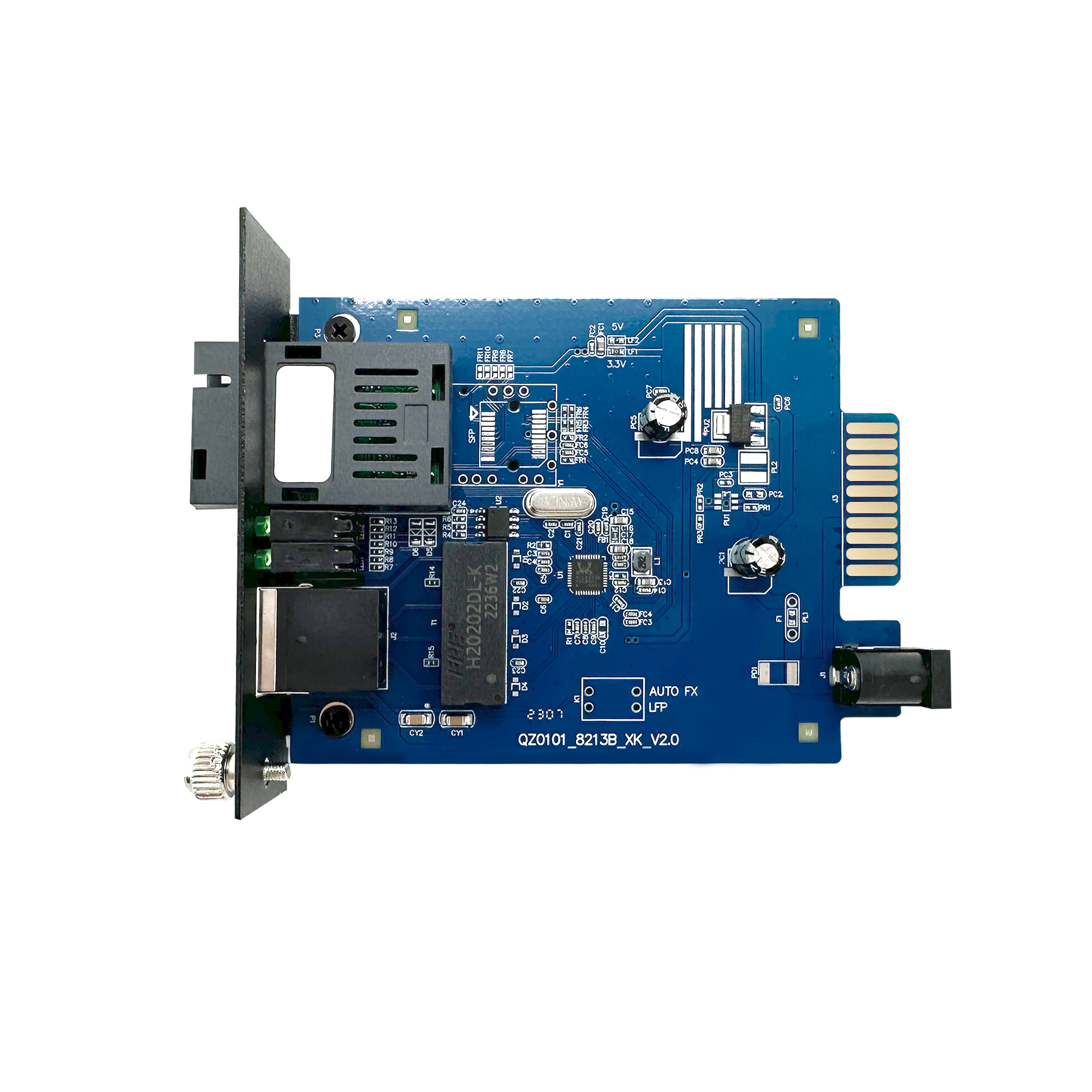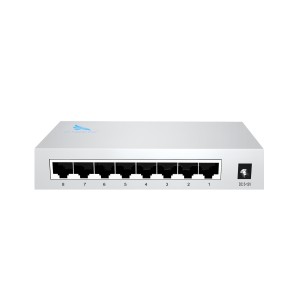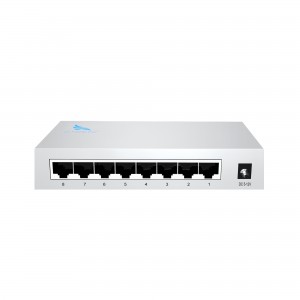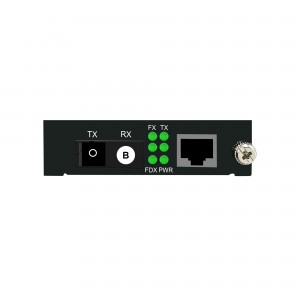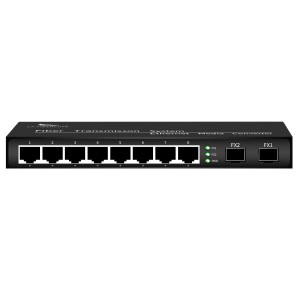2-port 10/100/1000M WDM Media Converter (Single-mode Single-fiber SC)
2-port 10/100/1000M WDM Media Converter (Single-mode Single-fiber SC)
Product Features:
Huizhou Changfei Photoelectric Technology Co., Ltd. launched a cutting-edge card type 1 optical 1 electrical single-mode single-fiber 20KM converter
In today’s fast-paced technology age, seamless connectivity has become a necessity for businesses across industries. As an innovative high-tech enterprise, Huizhou Changfei Optoelectronics Technology Co., Ltd. is well aware of this need and is committed to providing the most advanced network solutions. We are proud to present our latest product – Card Type 1 Optical 1 Electrical Single Mode Single Fiber 20KM Converter, a game changing device unmatched in performance and reliability.
The converter features our cutting-edge technology designed to enable seamless communication between different networks. The converter is capable of connecting 1000Base-T to fiber optics, and industrial fiber optic transceivers to SFPs, ensuring high-speed transmission and improving network efficiency. Say goodbye to the limitations of copper connections and embrace the power of fiber optic networks.
One of the outstanding features of this converter is its durable iron case design. This robust construction ensures the longevity of the device, making it ideal for use in harsh industrial environments. An IP30 rating further protects the converter from dust, debris and other external elements, ensuring uninterrupted operation even in harsh conditions.
Our converters feature an intelligently designed SC interface for a seamless, hassle-free connection. An external power supply further enhances ease of installation and provides flexibility for placement in network setups. This innovative combination of features makes our converters the solution of choice for businesses looking to enhance network capabilities without compromising reliability.
At Huizhou Changfei Photoelectric Technology Co., Ltd., we strive to provide products that meet the ever-changing needs of the industry. Our Card Type 1 Optical 1 Electrical Single Mode Single Fiber 20KM Converter is not only a technological marvel, but a testament to our commitment to quality and customer satisfaction. We understand the importance of reliable network solutions, and our converters are designed to deliver exceptional performance every time.
With our switches, businesses enjoy seamless connectivity, enhanced network efficiency and unmatched reliability. Whether you are a business looking to upgrade your network infrastructure, or a service provider striving to provide customers with best-in-class connectivity, our converters are perfect for you.
To sum up, Huizhou Changfei Optoelectronics Technology Co., Ltd.’s card-type 1 optical 1 electrical single-mode single-fiber 20KM converter provides unparalleled performance, reliability and convenience. With its steel housing design, IP30 degree of protection, SC interface and external power supply, the converter is the epitome of a modern network solution. Transform your network’s capabilities and take your connections to new heights with our state-of-the-art converter. Choose Huizhou Changfei Optoelectronics Technology Co., Ltd. for all your networking needs and experience the power of innovation today.
What This Product Does
◇ CF-101GSK-20A is a gigabit media converter, providing a gigabit RJ-45 port and a gigabit SC fiber port, which can convert between electrical and optical signals.
How This Product Works
◇ CF-101GSK-20A adopts WDM (wavelength division multiplexing) technology, helping send and receive data at a distance of up to 20 km with only a single mode fiber, which saves half of the cable deployment cost for customers. CF-101GSK-20A transmits data at 1310 nm wavelength and receives data at 1550 nm wavelength on optical fiber. Therefore, the terminal device used in conjunction with the CF-101GSK-20A should send data at a wavelength of 1550 nm and receive data at a wavelength of 1310 nm. CF FIBERLINK another media converter CF-101GSK-20B is one of the products that can cooperate with CF-101GSK-20A.
Other Features
◇ Besides, this media converter can be used as a standalone device (no rack required) or used with CF FIBERLINK’s CF-2U16 rack for auto MDI/MDI-X in TX port in which duplex mode is automatically negotiated.
technical parameter:
|
Model |
CF-101GSK-20A | |
| Interface Characteristics | ||
|
Fixed Port |
1* 10/ 100/ 1000Base-T RJ45 port 1* 1000Base-X uplink SC fiber port |
|
|
Ethernet Port |
10/ 100/ 1000Base-T auto-sensing, full/half duplex MDI/MDI-X self-adaption |
|
|
Twisted Pair Transmission |
10BASE-T: Cat3,4,5 UTP(≤100 meter) 100BASE-T: Cat5e or later UTP(≤100 meter) 1000BASE-T : Cat5e or later UTP(≤100 meter) |
|
| Optical Port | Default optical module is single-mode single-fiber 20km, SC port | |
| Wavelength/Distance | A-end: RX1310nm / RX1550nm 0 ~ 40KM
B-end:RX1550nm/ RX1310nm 0 ~ 40KM |
|
| A-end: RX1490nm / RX1550nm 0 ~ 120KM
B-end:RX1550nm/ RX1490nm 0 ~ 120KM |
||
| Chip Parameter | ||
| Network Protocol | IEEE802.3 10BASE-T, IEEE802.3i 10Base-T,
IEEE802.3u 100Base-TX, IEEE802.3u 100Base-FX, IEEE802.3x IEEE802.3ab 1000Base-T;IEEE802.3z 1000Base-X; |
|
|
Forwarding Mode |
Store and Forward(Full Wire Speed) |
|
|
Switching Capacity |
4Gbps |
|
|
Buffer Memory |
3Mpps | |
|
MAC |
2K | |
|
LED Indicator |
Fiber | FX(green) |
| Data | TP (green) | |
| Single / duplex | FDX (green) | |
| Power | PWR (green) | |
| Power | ||
| Working Voltage |
AC:100-240V |
|
|
Power Consumption |
Standby<1W, Full load<5W |
|
|
Power Supply |
DC:5V/2A industrial power supply |
|
| Lightning protection &Certification | ||
| Lightning protection | Lightning protection: 4KV 8/20us, Protection level: IP30 | |
| Certification | CCC;CE mark, commercial; CE/LVD EN60950;FCC Part 15 Class B; RoHS | |
| Physical Parameter | ||
| Operation TEMP | -20~+55°C;5%~90% RH Non condensing | |
| Storage TEMP |
-40~+85°C;5%~95% RH Non condensing |
|
| Dimension (L*W*H) | 98mm*75mm*2mm | |
| Installation | Desktop, CF-2U16 slot rack | |
Product Size:
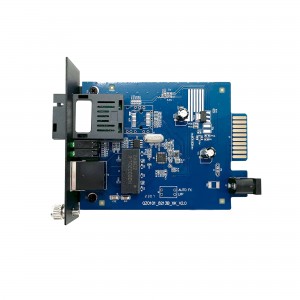
Product application diagra:

How to choose a fiber optic transceiver?
Optical fiber transceivers break the 100-meter limitation of Ethernet cables in data transmission. Relying on high-performance switching chips and large-capacity caches, while truly achieving non-blocking transmission and switching performance, they also provide balanced traffic, isolation and conflict. Error detection and other functions ensure high security and stability during data transmission. Therefore, fiber optic transceiver products will still be an indispensable part of actual network construction for a long time. So, how should we choose fiber optic transceivers?
1. Port function test
Mainly test whether each port can work normally in the duplex state of 10Mbps, 100Mbps and half-duplex state. At the same time, it should be tested whether each port can automatically select the highest transmission speed and automatically match the transmission rate of other devices. This test can be included in other tests.
2. Compatibility test
It mainly tests the connection ability between the optical fiber transceiver and other devices compatible with Ethernet and Fast Ethernet (including network card, HUB, Switch, optical network card, and optical switch). The requirement must be able to support the connection of compatible products.
3. Cable connection characteristics
Test the fiber optic transceiver’s ability to support network cables. First, test the connection ability of Category 5 network cables with lengths of 100m and 10m, and test the connection ability of long Category 5 network cables (120m) of different brands. During the test, the optical port of the transceiver is required to have a connection capability of 10Mbps and a rate of 100Mbps, and the highest must be able to connect to a full-duplex 100Mbps without transmission errors. Category 3 twisted pair cables may not be tested. Subtests can be included in other tests.
4. Transmission characteristics (transmission loss rate of data packets of different lengths, transmission speed)
It mainly tests the packet loss rate when the optical fiber transceiver optical port transmits different data packets, and the connection speed under different connection rates. For the packet loss rate, you can use the test software provided by the network card to test the packet loss rate when the packet size is 64, 512, 1518, 128 (optional) and 1000 (optional) bytes under different connection rates. , the number of packet errors, the number of packets sent and received must be more than 2,000,000. Test transmission speed can use perform3, ping and other software.
5. The compatibility of the whole machine to the transmission network protocol
It mainly tests the compatibility of fiber optic transceivers to network protocols, which can be tested in Novell, Windows and other environments. The following low-level network protocols such as TCP/IP, IPX, NETBIOS, DHCP, etc. must be tested, and the protocols that need to be broadcast must be tested. Optical transceivers are required to support these protocols (VLAN, QOS, COS, etc.).
6. Indicator status test
Test whether the status of the indicator light is consistent with the description of the panel and the user manual, and whether it is consistent with the current status of the fiber optic transceiver.


